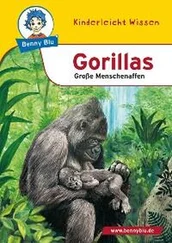Richard Garner - Gorillas & Chimpanzees
Здесь есть возможность читать онлайн «Richard Garner - Gorillas & Chimpanzees» — ознакомительный отрывок электронной книги совершенно бесплатно, а после прочтения отрывка купить полную версию. В некоторых случаях можно слушать аудио, скачать через торрент в формате fb2 и присутствует краткое содержание. Жанр: foreign_antique, foreign_prose, на английском языке. Описание произведения, (предисловие) а так же отзывы посетителей доступны на портале библиотеки ЛибКат.
- Название:Gorillas & Chimpanzees
- Автор:
- Жанр:
- Год:неизвестен
- ISBN:нет данных
- Рейтинг книги:3 / 5. Голосов: 1
-
Избранное:Добавить в избранное
- Отзывы:
-
Ваша оценка:
- 60
- 1
- 2
- 3
- 4
- 5
Gorillas & Chimpanzees: краткое содержание, описание и аннотация
Предлагаем к чтению аннотацию, описание, краткое содержание или предисловие (зависит от того, что написал сам автор книги «Gorillas & Chimpanzees»). Если вы не нашли необходимую информацию о книге — напишите в комментариях, мы постараемся отыскать её.
Gorillas & Chimpanzees — читать онлайн ознакомительный отрывок
Ниже представлен текст книги, разбитый по страницам. Система сохранения места последней прочитанной страницы, позволяет с удобством читать онлайн бесплатно книгу «Gorillas & Chimpanzees», без необходимости каждый раз заново искать на чём Вы остановились. Поставьте закладку, и сможете в любой момент перейти на страницу, на которой закончили чтение.
Интервал:
Закладка:
I fall asleep and rest in comfort, while the dew that has fallen on the leaves gathers itself into huge drops, their weight bends the leaves, and they fall from their lofty perch, striking those far below with a sharp, popping sound. The hours fly by, but in the stillness of the early morning is heard a most unearthly scream. It is a king gorilla. He simply makes every leaf in the forest tremble with the sound of his piercing shrieks.
The dawn again awakes to life the teeming forest, and all its denizens again go forth to join the universal chase for food.
All of these incidents cited are true in every detail, but they did not occur every day, nor did all of them occur on the same day, as would be inferred from the manner in which they are related.
This gives a glimpse of my real daily life in the jungle, but the monotony was often relieved by going out for a day or two at a time, or hunting on the plains, a few miles away. My menu was occasionally varied by a chicken, piece of goat, fish or porcupine; but the general average of it was about as described.
CHAPTER IV
THE CHIMPANZEE
Next to man, the chimpanzee occupies the highest plane in the scale of nature. His mental and social traits, together with his physical type, assign him to this place.
In his distribution, he is confined to Equatorial Africa. His habitat, roughly outlined, is from the fourth parallel north of the equator to the fifth parallel south of it, along the west coast, and extends eastward about half-way across the continent. His range can be defined with more precision, but its exact limits are not quite certain. Its boundary on the north is defined by the Kameroon valley, slightly curving to the north, but its extent eastward is not well known. He does not appear to be found anywhere north of this river, and it is quite certain that the few specimens attributed to the north coast of the Gulf of Guinea do not belong to that territory. On the south, its boundary starts from the coast, at a point near the fifth parallel, curves northward, crossing the Congo near Stanley Pool, pursues a north-east course, to the centre of the Congo State, again curves southward, across the Upper Congo, towards the north end of Lake Tanganyika. Its limits appear to conform more to isothermal lines, than to the rigid lines of geometry.
Specimens are sometimes secured by collectors beyond the limits mentioned, but so far as I can ascertain they appear to have been captured within these limits. There are numerous centres of population. This ape is not strictly confined to any definite topography, but occupies the upland forests or the low basin lands.
In one section he is known to the natives by one name, and in another by quite a different one. The name chimpanzee is of native origin. In the Fiot tongue the name of the ape is chimpan , which is a slight corruption of the true name. It is properly a compound word, the first syllable is from the Fiot word tyi , which white men erroneously pronounce like "chee." It means "small," and is found in many of the native compounds. The latter syllable is from mpâ , a bushman, hence the word literally means, in the Fiot tongue, "a small bushman."
Among other tribes the common name of the ape is ntyigo . The two names appear to come from the same ultimate source. The latter is derived from the Mpongwe word ntyia , blood, hence breed, and the word iga , the forest, and literally means the "breed of the forest." The same idea is involved in the two names, and both convey the oblique idea that the animal is something more like man than other animals are.
There are two distinct types of this ape, and they are now regarded as two species. One of them is distributed throughout the entire habitat described, while the other is only known south of the equator, between the second and fifth parallels, and west of the Congo. Both kinds are found within these limits, but the variety which is confined to that region is called, by the tribes that know the ape, the kulu-kamba , in contradistinction to the other kind, known as ntyigo . This name is derived from kulu , the onomotope of the sound made by the animal and the native verb kamba , to speak, hence the name literally means the thing "that speaks kulu."
In certain points the common variety differs from the kulu-kamba in a degree that would indicate that they belong to distinct species, but the skulls and skeletons are so nearly the same, that no one can identify them with certainty. In life, however, it is not difficult to distinguish them.
The ntyigo has a longer face and more prominent nose than the kulu . His complexion is of all shades of brown, from a light tan to a dark, dingy mummy colour. He has a thin coat of short black hair, which is often described as brown, but that effect is due to the colour of his skin blending with that of his suit. In early life his hair is quite black, but in advanced age the ends are tipped with a dull white, giving him a dingy grey colour. The change is due to the same causes that produce grey hairs on the human body. But there is one point in which they differ. The entire hair of the human becomes white with age, while only the end of it does so in the chimpanzee. In the human, one hair becomes white, while another retains its natural colour, but in this ape all the hairs appear to undergo the same change.
In very aged specimens the outer part of the hair often assumes a dirty, brownish colour, which is due to the want of vascular action to supply the colour pigment, and the same effect is often seen in preserved specimens, for the same reason that the hair of an Egyptian mummy is brown, while in life it was doubtless a jet black. In this ape the hair is uniformly black, except the small tuft of white at the base of the spinal column and a few white hairs on the lower lip and chin. I have examined about sixty living specimens and I have never found any other colour among them only from the cause mentioned. The normal colour of both sexes is the same.
The kulu , as a rule, has but little hair on the top of its head, but that on the back of it and on the neck is much longer than elsewhere on the body, and longer on them than on other apes.
Much stress is laid by some writers on the bald head of one ape and the parted hair on that of another. These features cannot be relied upon as having any specific meaning, unless there are as many species as there are apes. Sometimes a specimen has no hair on the summit of its head, while another differs from it in this respect alone by having a suit of hair more or less dense, and yet in every other respect they are the same. Some of them have the hair growing almost down to the eyebrows, and each hair appears to diverge from a common centre like the radii of a sphere: another of the same species will have the hair parted in the middle as neatly as if it had been combed, while another may have it in wild disorder. The same thing is noticed in certain monkeys, and it is equally true of the human being. As a factor in classifying them it signifies nothing. It may be remarked that as a whole the kulu is inclined to have little hair upon the crown of the head.
Between the two species there is a close alliance, but the males differ more than the females. This is especially true in the structure of certain organs.
The face in youth is quite free from hairs, but in the adult state there is, in both sexes, a slight tendency to grow a light down over the cheeks.
The colour of the skin is not uniform in all parts of the body, especially on the face. Some specimens have patches of dark colour set in a lighter ground. Sometimes certain parts of the face will be dark, and other parts light. I have seen one specimen quite freckled.
Читать дальшеИнтервал:
Закладка:
Похожие книги на «Gorillas & Chimpanzees»
Представляем Вашему вниманию похожие книги на «Gorillas & Chimpanzees» списком для выбора. Мы отобрали схожую по названию и смыслу литературу в надежде предоставить читателям больше вариантов отыскать новые, интересные, ещё непрочитанные произведения.
Обсуждение, отзывы о книге «Gorillas & Chimpanzees» и просто собственные мнения читателей. Оставьте ваши комментарии, напишите, что Вы думаете о произведении, его смысле или главных героях. Укажите что конкретно понравилось, а что нет, и почему Вы так считаете.












